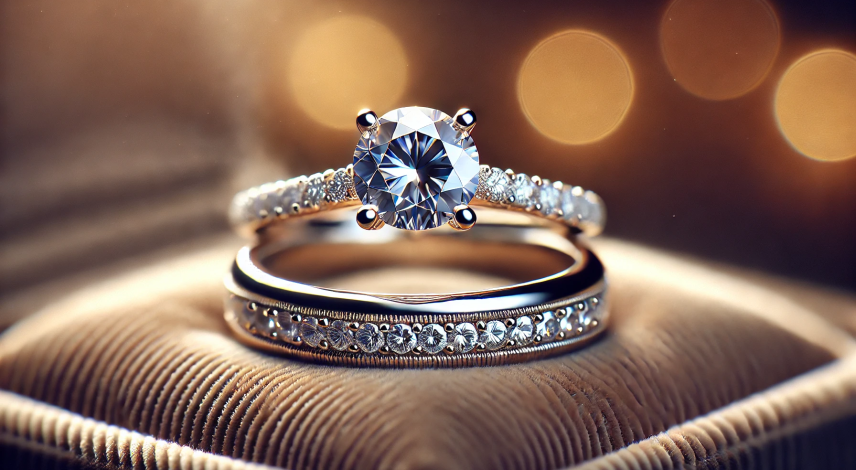


shop BY BAND STYLES
shop BY STONE ARRANGEMENTS
shop BY DESIGN STYLES
shop BY METAL COLOR
shop BY STONE TYPES
shop BY BAND STYLES
shop BY STONE ARRANGEMENTS
shop BY DESIGN STYLES
shop BY METAL COLOR
shop BY STONE TYPES
shop BY BAND STYLES
shop BY STONE ARRANGEMENTS
shop BY STONE TYPES
shop BY METAL COLOR
SHOP BY STYLE
GIFTS BY OCCASION
GIFTS BY PRICE

✚ BY BAND STYLES
✚ BY STONE ARRANGEMENTS

Every love story carries unique milestones, and two of the most significant symbols of commitment are the engagement ring and the wedding ring. While both represent love and devotion, they hold different meanings, traditions, and roles in a couple’s journey. If you’ve ever wondered about the difference between an engagement ring and a wedding ring—or how to choose the right ones—this guide will help you navigate the traditions, styles, and modern trends behind these timeless pieces of jewelry.
An engagement ring is traditionally presented during a proposal as a symbol of promise and intention to marry. It often features a prominent gemstone that makes it instantly recognizable.
Typical designs include:
In recent years, many couples have embraced alternatives such as sapphires, emeralds, morganite, or moissanite engagement rings. Sustainable options like lab-grown diamonds and recycled gold have also grown popular, offering beauty without compromising values.
Vintage Pear Cut Lab Diamond Halo Engagement Ring 14K Yellow Gold
A wedding ring—also called a wedding band—is exchanged during the wedding ceremony itself. Unlike the engagement ring, which emphasizes a central gemstone, the wedding ring is usually more understated and designed for everyday wear.
Popular wedding ring styles include:
Wedding rings symbolize unity and commitment. Today, couples often choose modern designs like unisex wedding bands, black gold rings, or mixed-metal combinations that reflect their personal style.
Pattiring Marquise Cut London Blue Topaz Rose Gold Half Eternity Wedding Band
Aspect | Engagement Ring | Wedding Ring |
Design | Bold, with a central gemstone (diamond or colored stone). | Simple, often without a large stone. |
Meaning | Symbol of promise and proposal. | Symbol of marriage and lifelong commitment. |
Timing | Given at the proposal. | Exchanged during the wedding ceremony. |
Price | Typically more expensive due to gemstones and settings. | Usually less cos tly, though eternity bands may be higher. |
Tradition | Often worn by one partner. | Worn by both partners after marriage. |
Traditionally, wedding bands are placed on the ring finger first—closest to the heart—followed by the engagement ring. Some prefer to wear only one ring, while others stack multiple rings for a layered look.
Options include:
Ultimately, there are no strict rules—it’s about what feels meaningful and comfortable to you.
Pear Cut London Blue Topaz Engagement Ring Set with Sparkling Cluster
Rings are more than beautiful pieces of jewelry—they are symbols of love, milestones, and promises. Each type of ring carries its own unique meaning:
Wedding Ring: Exchanged during the wedding ceremony, this band represents eternal unity, loyalty, and the bond that lasts a lifetime. Its circular shape—with no beginning and no end—is the ultimate symbol of infinity.
Eternity Band: Often gifted during anniversaries or after major milestones, the eternity ring is set with continuous gemstones, representing endless love and devotion.
Gemstones with Meaning:
Diamond: Strength, purity, and eternal love.
Sapphire: Loyalty and wisdom.
Emerald: Growth, hope, and renewal.
Ruby: Passion and courage.
Personal touches, like engraving initials, wedding dates, or meaningful quotes, transform a ring from a piece of jewelry into a deeply personal heirloom. These small details tell a story that only you and your partner truly share.
Every ring tells a love story—what matters most is the meaning it holds for you and your partner.
Today’s couples value rings that tell a personal story. Some of the most exciting trends include:
Engagement rings and wedding rings may serve different purposes, but together they tell the story of love, commitment, and unity. The engagement ring marks the beginning of a promise, while the wedding ring seals that promise into a lifelong bond. Whether you choose a classic diamond solitaire, a sleek plain band, or a unique custom design, the most important factor is that your rings resonate with your personal story and symbolize the love you share.
Engagement rings are given during a proposal, usually featuring a center gemstone, while wedding rings are exchanged at the wedding ceremony and are often simpler bands.
Yes, many people wear both. Typically, the wedding band is placed first on the finger, followed by the engagement ring. Some people choose to wear only one.
Traditionally, the wedding ring is worn first, closest to the heart, followed by the engagement ring.
Yes. Some couples choose one ring that serves both purposes, especially if they prefer a minimalist or budget-friendly approach.
Engagement rings are usually more expensive due to larger gemstones, while wedding bands tend to cost less. However, budget depends on personal preference, style, and materials.
Not necessarily. Many couples choose complementary designs, while others prefer mixing metals and styles for a unique look.
In most Western traditions, both are worn on the left ring finger. In some cultures, they are worn on the right hand.
No. While diamond wedding bands are popular, plain gold, platinum, or even gemstone bands are equally common.
Yes. More men today wear engagement rings, and unisex ring designs are becoming increasingly popular.
A wedding band can be plain or have small stones, while an eternity band has gemstones all around and is often chosen to symbolize everlasting love.